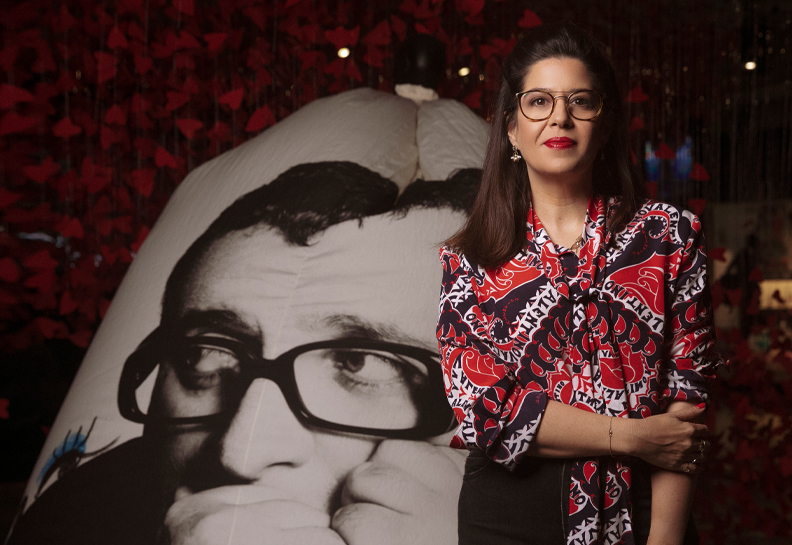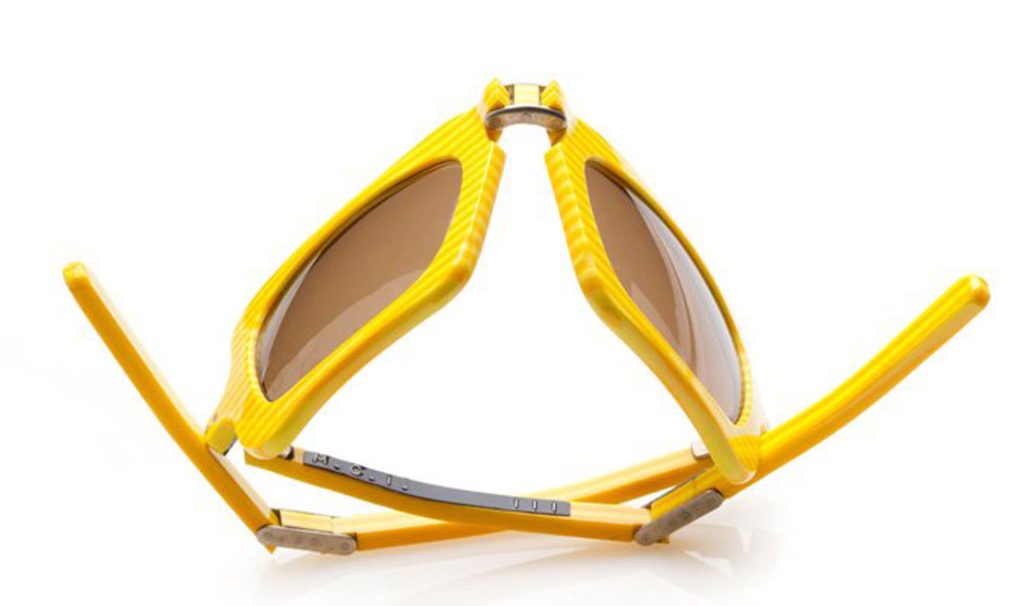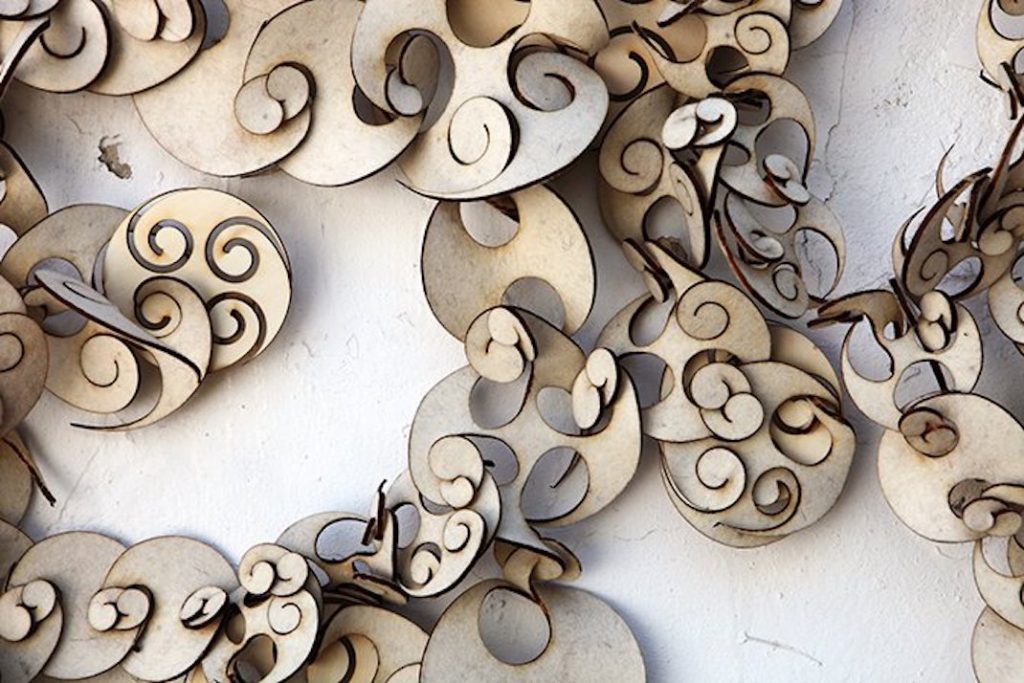Currently showing at the Museum is jewelry designer Dana Hakim Bercovich’s first solo exhibition in Israel, “Beyond the Mesh”, which is also the first exhibition at the Museum entirely devoted to jewelry design and to a single jewelry designer. Hakim has shown her work in dozens of group exhibitions in Europe, the US, and Asia. Next stop: a solo exhibition in Shanghai.
The collections showing at the Museum are made from a dominant material – old loudspeaker mesh. So what came first, the idea or the material? What is your work method?
The answer to this question begins in the education and training I received in the Department of Jewelry and Fashion Design at Bezalel Academy of Arts and Design, where I currently teach. At Bezalel emphasis is placed on developing the idea behind the final product and, beyond the numerous technical tools students acquire there, that is the Department’s uniqueness and strength. I believe a piece of jewelry is an object by means of which you can communicate, and jewelry design is part of the plastic arts domain. In my practice I begin by developing a concept and choosing the materials at the same time, and the shapes and colors derive from there. Additionally, every material has a life of its own, and frequently my hands also work almost of their own volition, without me thinking too much.
In the first stages of my work I formulate the ideas in writing and adhere to them and to the inspiration board I build for myself, but later, when I start working at my worktable, I let go of them, disconnect from them so as not to limit myself, and you won’t find a single visual reference image or clever quote in the creating stage. I don’t make sketches either, other than seldom three-dimensional ones. Most of my works are composed of several experiments on the same mesh. I begin with a particular element and then examine it while I work on it. It’s a game of back-and-forth, and a bit of getting lost. That is the gift I received in my MA studies at Konstfack University College of Arts where more time is given to creating alone, without supervision, and to understanding how you function in a studio and the work method most suited to you as a creator.
My studio is small. All the walls are covered in open floor-to-ceiling cupboards, a torso, a jeweler’s bench, a simple expandable worktable, and a few good tools. In jewelry making you can do a lot of the work on your own and anywhere, and that’s one of the things I love about it. I can move to another country and all I need in order to start working is a table, a few hand tools, and a dremel (a small filing and polishing tool).
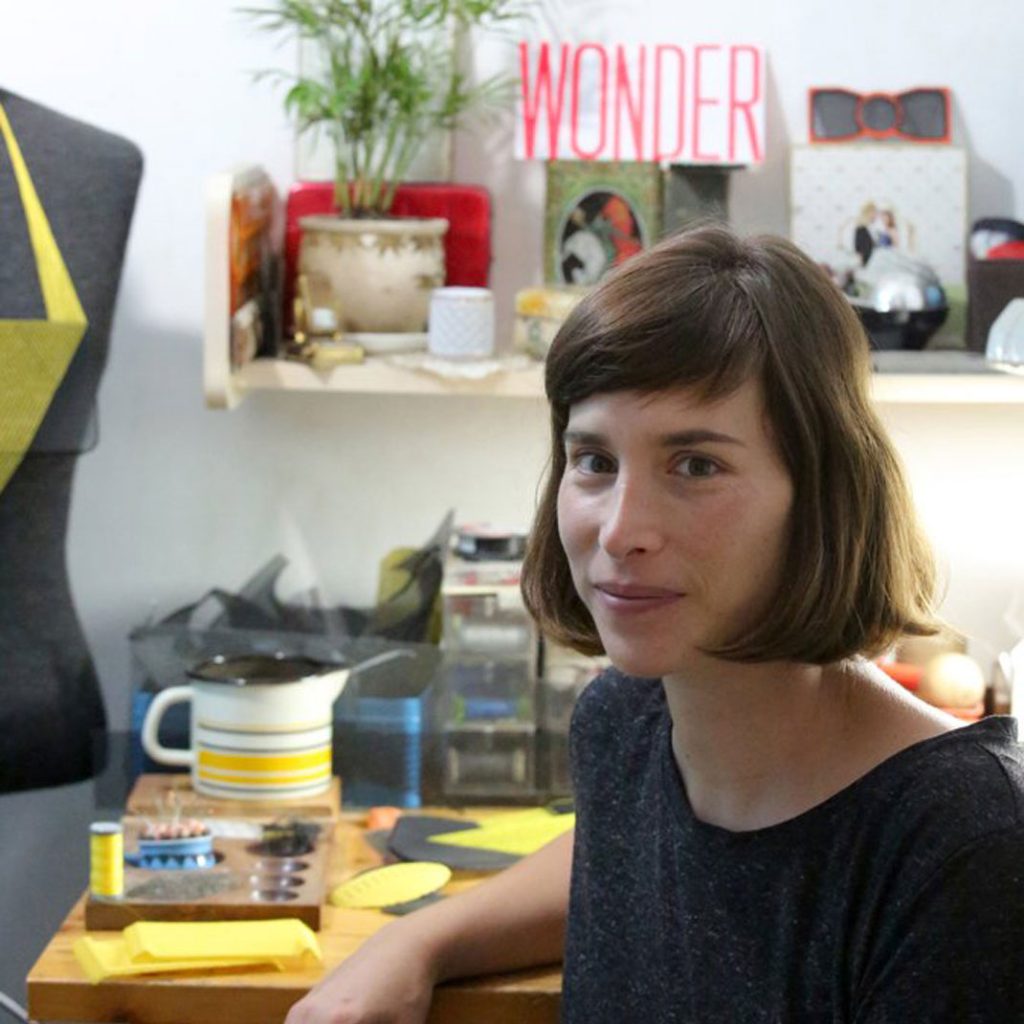
What led you use loudspeaker mesh?
In my MA graduation project I presented a collection of contemporary amulets titled “My Four Guardian Angels”, which responds to people’s fears in the present day. I wanted to work with readymade materials, and they served as raw materials that can communicate subjects such as protection and safekeeping and connect with the morphology and color of amulets from North Africa, which are quite easily identifiable with our region. Some of the amulets were made from work gloves, which corresponded with the subject of the protecting hamsa/hand, and the loudspeaker mesh was incorporated into them; that was the beginning.
Another amulet I focused on is an amulet against the evil eye, which is prevalent in numerous cultures, and which led me to engage with security cameras as an analogy for the all-seeing eye, Big Brother. I also examined the ornamentics of amulets, which can be seen in jewelry and textiles – where there is an abstraction of symbols and shapes, and recurring geometric shapes. For example, a rug is actually an amulet for the home, and the central medallion, the big rhombus, is an abstraction of the shape of an eye. In my project I made use of various readymade materials that connected with the subject even when they were taken out of context, like sawn silver Christmas baubles that served as lenses in the pieces of jewelry, artificial black rubber grapes, and various meshes, including loudspeaker mesh. They suited the work since they possess delicate, material, and jewelry-making qualities that appealed to me. I continued with them into my next collection as well, which is now showing in the exhibition at the Museum.
While working with the mesh I discovered many things, and I wanted to continue working with it without repeating the same ideas. It took me time to understand what I want to talk about this time, and in the end I continued my general engagement with amulets, only this time they were pieces of jewelry that indicate danger and a warning against that danger by visual means. The entire collection was painted yellow and black, warning colors employed by animals in the wild, such as bees and wasps, and it is no coincidence that these are also the colors used in radioactive symbols, warning signs, and signage. Accordingly, this collection is flat and more graphic.
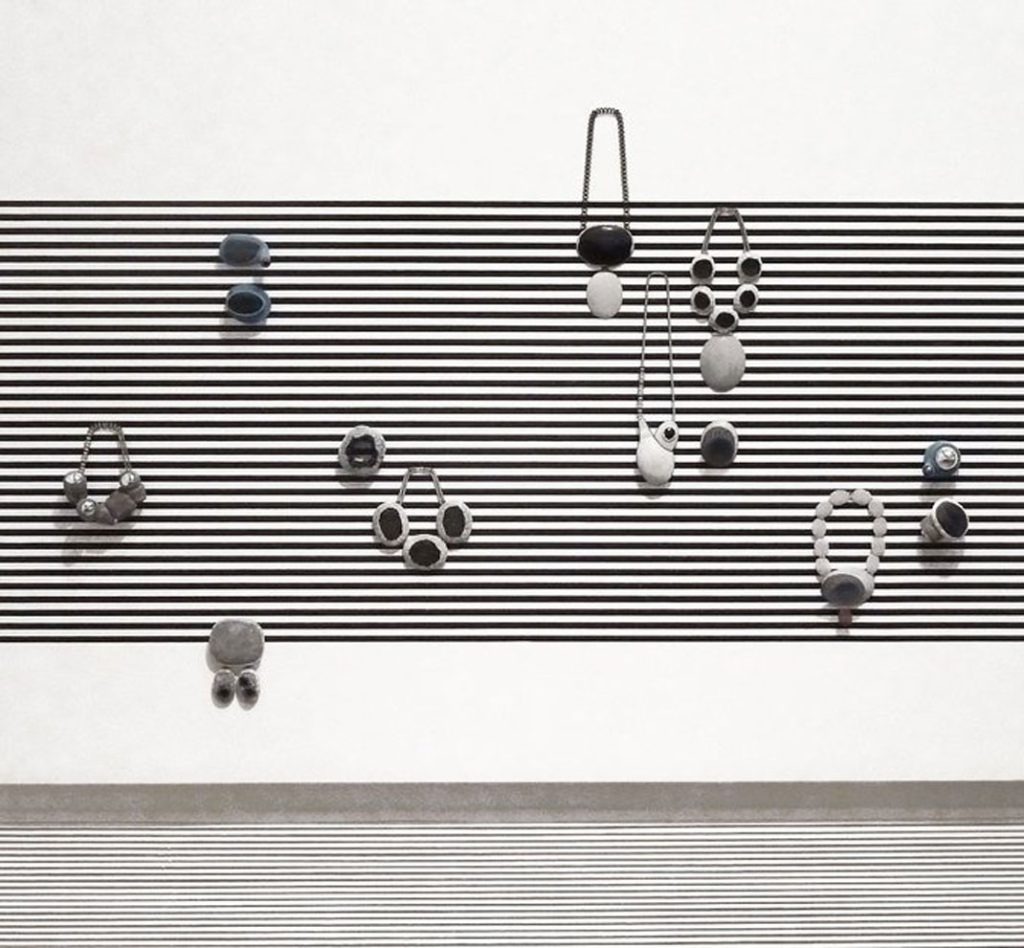
Let’s talk about jewelry exhibitions. In what way do you think jewelry exhibitions differ from design and art exhibitions?
In general, I associate jewelry making with the world of craft and everyday applied art. For a pin to stay in its place and not move, you have to plan the clasp as part of the design. In other words, what I like about real, quality jewelry making is that even the simplest of mechanisms requires meticulous crafting and sophisticated thinking. But in jewelry making as well, there are objects that express more abstract ideas.
Similar trends and curating changes that occurred in the art world also occurred at the same time in design and applied arts exhibitions. Since the 1960s and 70s we are seeing curators who commission works for exhibitions in accordance with a particular idea, and the independent curator’s power is increasingly growing. In recent years we are seeing more and more such exhibitions in the sphere of jewelry making, so choosing a particular jeweler or the jewelry making medium in general is done in accordance with the direction in which the curator wants to go with the exhibition and his chosen theme. Additionally, jewelry design exhibitions are no longer always closed behind display cases, and seek to make the pieces of jewelry accessible to the viewer, who tends to imagine them on the body. Distancing and closing is gradually disappearing. Multidisciplinarity is a highly significant concept in the world of design, and although it is not new I still feel that it is developing in the jewelry design galleries as well, which are recently also incorporating performance, video works, sculptures, and paintings.
A chair can still exist without the person using it; what happens with jewelry? Is there meaning to the presentation of a piece of jewelry without a human body?
A piece of jewelry hanging on a wall or placed in a drawer exists in it, and the drawer is an additional natural environment for it, and just like a chair, the piece of jewelry without the person using it indicates the absent present, so what’s the difference? We know what the specific object’s traditional connection is with the body, how you sit on it or how you wear it, and from there derive the meanings and the interplay with breaking the rules and shapes. I usually present a piece of jewelry on its own, but I’m not sure it’s always right for my pieces, and sometimes it stems from budgetary and time constraints. I’ve seen wonderful exhibitions in which the pieces of jewelry very successfully present their connection to the body and being worn. Pieces of jewelry hung on a wall above pairs of shoes, materials on a hanger and the jewelry over them, white shirts attached to a wall with masking tape and jewelry hanging on them. Last year there was an excellent end-of-year exhibition at the academy in Munich, which has one of the world’s best jewelry design departments. In the exhibition, changing images of people were projected by multiple projectors onto the pieces of jewelry that were hung on the wall. In another exhibition, there were just hooks attached to the walls on which jackets were hung, seemingly nonchalantly. Attached to all the pockets of the jackets were pins at precise angles, which were in fact the exhibits in the exhibition.
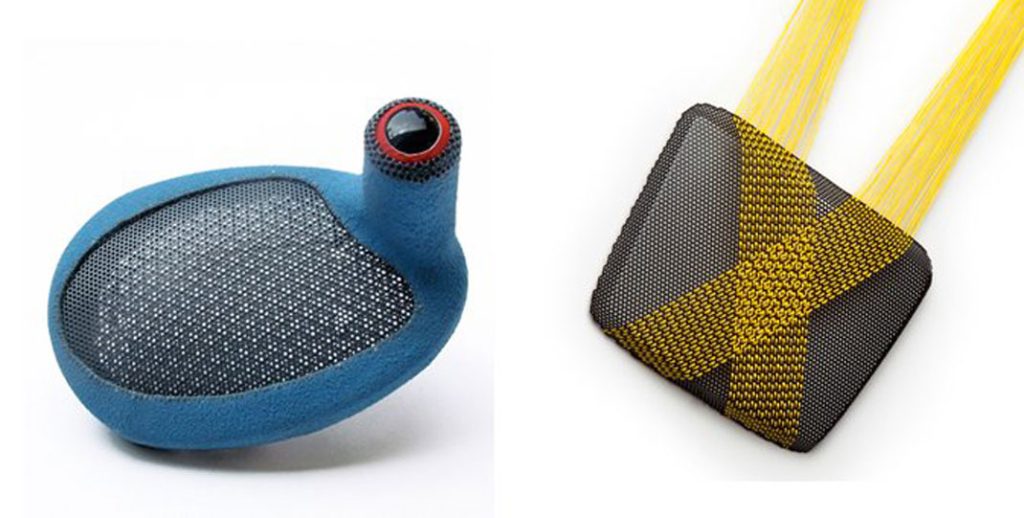
Which jewelry designs or designers do you like, admire?
I really admire the work of Prof. Iris Eichenberg, a German jewelry designer who headed the Jewelry Department at Gerrit Rietveld Academie in Amsterdam, and currently heads the Metalsmithing Department at Cranbrook Academy of Art in the US. On the one hand she works very intuitively, but on the other she works within a kind of frame story she wants us to understand, or to not understand anything from it. I attended a short workshop she gave as part of a koru (jewelry) week in Finland, and she had a considerable influence on me. I also really like Noon Passama, a young Thai jewelry designer who studied and works in Holland. She has a wide and fascinating range of works, and what I find particularly interesting is the way she zigzags between artistic and industrial work. She has a good and correct connection with the fashion accessory industry which is manifested in collaborations with fashion designers and the advanced technologies and materials she uses.
Do you think jewelry design is somewhat lagging behind industrial or fashion design, which made it into museums earlier?
It really depends on the geographic region. Europe and the US have been leading players for decades, and in Asia, South America, Australia, and New Zealand as well there is a lot of activity and endeavor in the sphere. There are countries with more extensive foundations that enable ongoing endeavor over the years. There jewelry design participates in group design and art exhibitions. Solo jewelry design exhibitions are frequently shown in museums, jewelry pieces have been part of the museums’ permanent collections for a long time, and the artists receive support from the state and from design and art foundations, and can invest time in creating rather than in the race to make a living. In most of these places there are galleries specializing in artistic jewelry design. They have a list of artists they represent, for whom they serve as agents, similar to the way art galleries operate. The galleries undertake to present our works in and outside the gallery, at fairs specializing in design and which are located on the intersection between art and design, and in applied art fairs and museum exhibitions.
And what about the local field? Are there galleries here that show and sell jewelry?
Not exactly. There are excellent design galleries that occasionally show jewelry design exhibitions. When I graduated from Bezalel, a few graduates tried to open a contemporary jewelry gallery in Jerusalem, which we called Zigurrat, and which operated for about two years. We understood the importance of contemporary jewelry having a home, a permanent place to show and sell it, and I still think this way, and I feel the absence of a gallery such as that. We mounted a few exhibitions and tried to develop courses and sell our work, but it was very hard to sustain it, and also to understand what we wanted from ourselves at the start of our artistic careers. As an Israeli creator I have personal responsibility for the local field since I chose to work in it, and I am also teaching a new generation of jewelry designers here. It is important to continue curating exhibitions in Israel and showing jewelry in all kinds of spaces and collaborating with different entities, institutional and commercial alike. There is a need for all the infrastructures around us to work in this direction too, not only the creators themselves. Therefore, the exposure jewelry design is now receiving in the Museum is very important for the field’s propulsion, beyond my own personal satisfaction.
Is there an item you designed that you are particularly attached to?
There are pieces I prefer and think that in them I achieved meaningful successes, but that doesn’t mean I’ll keep them. Fortunately or unfortunately they never all leave me, because not all of them are sold. I offer my jewelry for sale, it’s a necessity in the current economic reality, and it’s also the main reason for which they were created, not to lie in my cupboard. I have come to terms with the fact that they are displayed or worn, and take on a life of their own somewhere else.
And thoughts for the future? Is there a continuation to these series?
I’m going to Shanghai for a solo exhibition in mid-September. Noga Shahar, my agent from NOGART CN, commissioned a specific collection which is based on the artistic mesh collections with a view to the more esthetic and commercial aspect, and thinking about what the Chinese public wants to wear – a challenging aspect for me. The new observation of a series comprising several dozen items and continuing creation always make me happy, and that’s where I feel I’m in my natural place. Things seep from the commercial to the artistic and vice versa. The idea is to always be active.
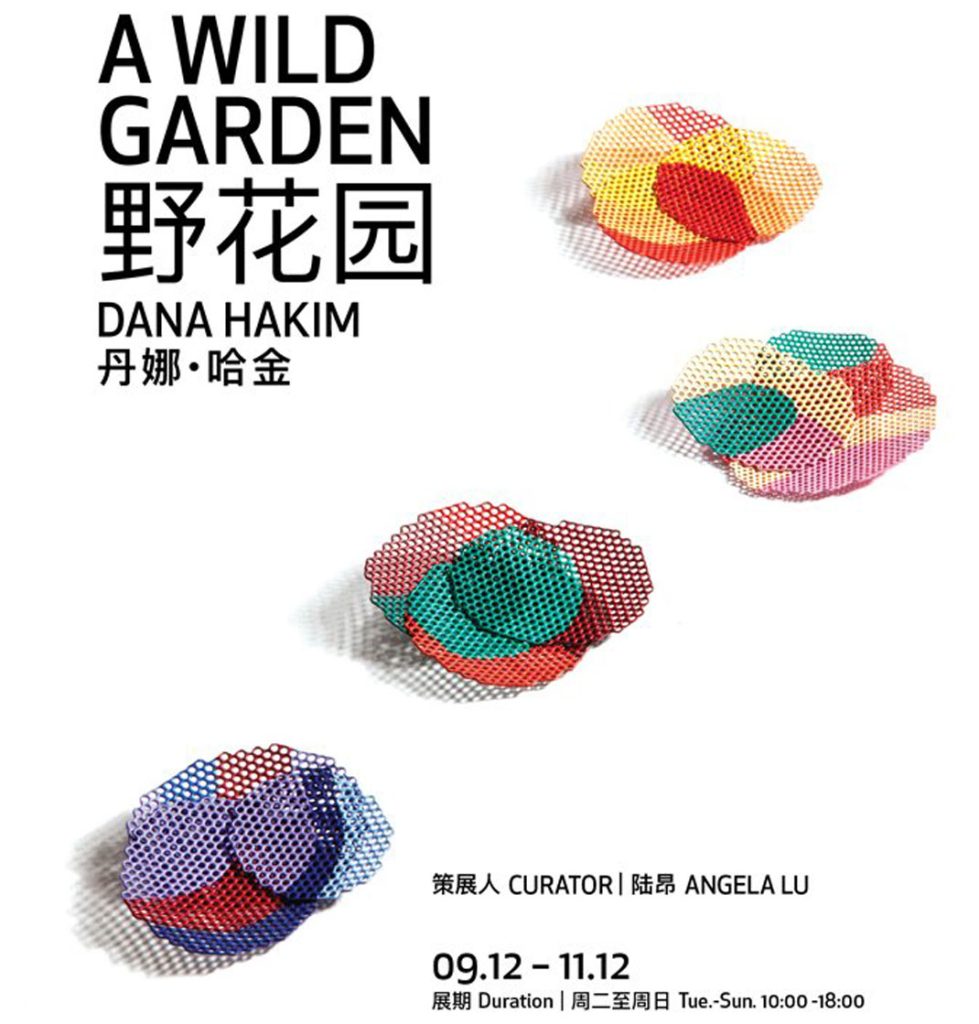
Do you have a big dream you haven’t yet fulfilled? A place where you’d like to show that would be a pinnacle for you?
I feel that I am already living my dream, my works are developing over the years, and people are responding to them accordingly, even beyond my expectations, I’m teaching at Bezalel and in academe it’s always interesting, and I really enjoy my encounters with students. I aimed for jewelry design to be my profession and not remain within the bounds of a hobby. It was important to me to have jewelry galleries that represent me in the world, so they take care of creating schedules for exhibitions for me, and exhibitions also mean sales, which is no less important. At the beginning of my career I endeavored to participate in a lot of group exhibitions, in competitions, and work incessantly, and it was all worthwhile because at some point the galleries started approaching me and were prepared to take a gamble on me. They look for people with ambition who are working and creating. I’d like to continue showing more often and to agree to participate in all kinds of interesting projects that are offered to me, but often I have to decline due to time constraints. As far as I’m concerned, right now things are moving at an almost optimal pace, all that’s missing now is time to work in my studio, which has recently become a valuable commodity.
